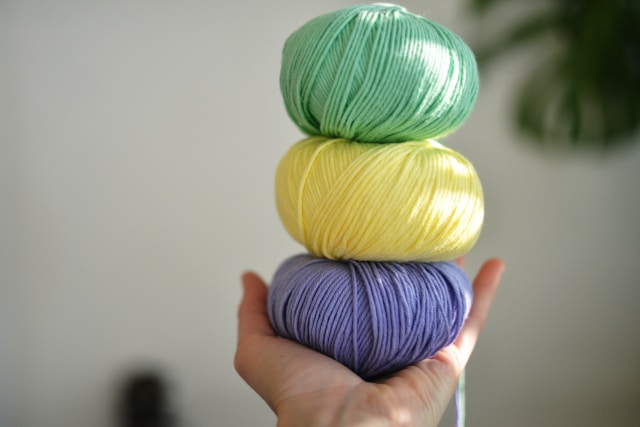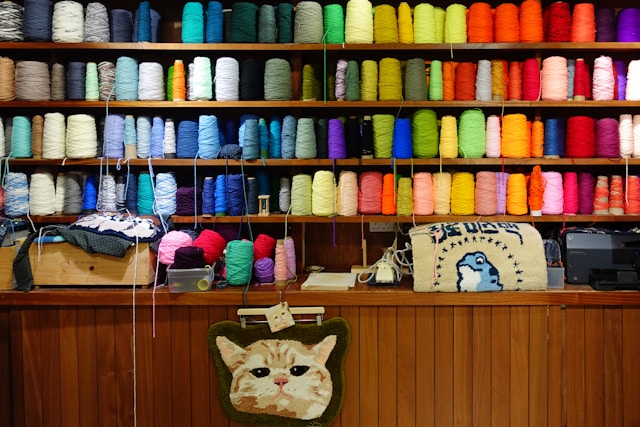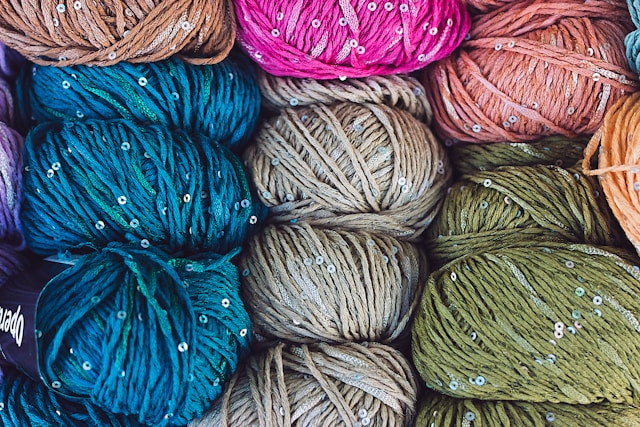Does this sound familiar? You find a beautiful skein of yarn, soft and full of creative possibility, but instead of using it, you tuck it away—saving it for the “perfect project.” Or maybe you start a project, realize it’s not working out, and feel like you’ve “wasted” your materials and your time. If so, you’re not alone. Many fiber artists struggle with the fear of wasting yarn, fabric, or thread, which can hold us back from fully engaging with our creativity.
But here’s the truth: Every stitch, every experiment, and every “failed” project has value. Let’s explore how to break free from this perfectionist mindset and start crafting with more joy and freedom.
Craft to Heal is a workshop series exploring ways to amplify the benefits of your fiber craft. Overcoming challenges like the fear of wasted yarn is one example. Learn more here.
Why We Fear “Wasting” Our Craft Supplies
The fear of wasting yarn (or fabric, or thread) often comes from deep-rooted perfectionism and scarcity thinking. Here’s why so many fiber artists struggle with it:
1️⃣ The Myth of the “Perfect Project”
Many fiber artists fall into the trap of waiting for the “perfect” project—a project that feels worthy of their most treasured yarn or fabric. This hesitation is deeply tied to perfectionism, fear of failure, and scarcity mindset—all of which are psychological patterns that can hold us back creatively.
📌 Why Do We Wait? The Perfectionist’s Cycle
The “perfect project” mentality is a form of all-or-nothing thinking, a cognitive distortion in which we believe that something is either ideal or a failure, with no in-between. This mindset creates a cycle of hesitation that looks like this:
1️⃣ We feel attached to a special material → “This yarn is too nice to waste on just any project.”
2️⃣ We set impossibly high standards → “I need to find the perfect pattern, or I’ll regret using it.”
3️⃣ We fear disappointment → “What if I start, and it doesn’t turn out how I imagined?”
4️⃣ We avoid committing to a project → “I’ll wait until I’m more skilled / find the perfect pattern / feel more confident.”
5️⃣ The longer we wait, the harder it becomes → “Now I feel even more pressure not to mess this up.”
The result? We accumulate more and more materials that remain untouched, reinforcing the false belief that we must wait until we are “good enough” to use them.
Perfectionism and Anxiety
The “perfect project” mentality is often more than just a creative block—it’s deeply tied to anxiety, perfectionism, and even avoidance behaviors that show up in other areas of life. For many fiber artists, the hesitation to use a special skein of yarn or start a project reflects a fear of making the “wrong” choice, which is a hallmark of decision paralysis and perfectionist thinking. Anxiety thrives in uncertainty, and when we place too much pressure on making the “right” decision, our brains default to avoidance. Instead of risking disappointment, we wait—telling ourselves that someday we’ll feel more confident, more prepared, or more skilled. But that moment never really arrives, because perfectionism sets the bar just out of reach every time.
This cycle can be particularly frustrating for those who struggle with generalized anxiety disorder (GAD), obsessive-compulsive tendencies (OCD), or ADHD, where decision fatigue, fear of failure, and perfectionism are common patterns. Anxiety tells us that if we wait just a little longer—find the perfect pattern, develop better skills, feel more ready—then we’ll avoid the regret of wasting something valuable. But in reality, waiting only strengthens the fear. The longer we put off using our materials, the more pressure we place on ourselves when we finally do. What should be a joyful, creative act becomes weighed down with unnecessary emotional baggage.
The irony is that crafting itself can be a powerful tool for easing anxiety and interrupting perfectionist thought loops—but only if we let it. The moment we stop overanalyzing the outcome and just start, the weight of indecision lifts. Even if we end up frogging a project or setting it aside, we still gain something valuable: the experience of making, the act of trying, the tactile relief of engaging in fiber arts without judgment. The only true waste is letting materials sit untouched while we wait for a perfection that doesn’t exist.
2️⃣ The Pressure of Expensive or Special Yarn
Maybe you splurged on a hand-dyed skein or were gifted luxury fiber that feels too precious to “mess up.” Instead of taking the risk, you let it sit unused, which ironically wastes it more than using it imperfectly ever could.
The pressure of using expensive or special yarn is often about more than just the material itself—it can be deeply connected to self-worth, scarcity mindset, and even symptoms of depression or low self-esteem. When we hesitate to use something valuable, we may not just be protecting the yarn; we may be protecting ourselves from the discomfort of feeling undeserving of something precious. This can be especially true for those who struggle with self-doubt, imposter syndrome, or depression, where the underlying belief might be: “I’m not good enough to use this yet,” or “My skills don’t justify working with something this nice.”
This hesitation also taps into a scarcity mindset, a psychological phenomenon where we treat resources—whether money, time, or materials—as if they are finite and irreplaceable. This kind of thinking is often heightened by anxiety or depression, where decision-making feels overwhelming, and the fear of making the “wrong” choice leads to inaction instead of creation. The paradox is that by avoiding “wasting” the yarn, we end up wasting its potential—denying ourselves the very joy and therapeutic benefits that fiber arts can provide.
For those living with depression, crafting can be a way back into creativity, self-care, and even connection with others—but only if we allow ourselves to engage with it. Instead of waiting until we feel “worthy” or “ready,” what if we viewed that special yarn as a tool for healing, rather than a test of skill? The act of using it—even imperfectly—becomes an act of self-compassion rather than a risk. Because in the end, the value of the yarn isn’t in its perfection—it’s in the experience of making something with our hands, exactly where we are, as we are.

3️⃣ Fear of “Ruining” a Project
We often think, “What if I start and mess it up?” This fear stops us from experimenting with new stitches, patterns, or color combinations. The irony? The only way to get better is to try, fail, and try again.
The fear of “messing up” can feel overwhelming, especially when working with new techniques or special materials. It’s easy to believe that if we don’t get it right the first time, we’ve somehow failed. But in reality, creativity thrives on experimentation, and every so-called mistake is just part of the learning process. The only way to improve is to try, fail, and try again.
🔹 What’s really behind this fear?
- Perfectionism – Feeling like every project has to be flawless before it’s even started.
- Fear of wasted time or materials – Worrying that if something doesn’t turn out, we’ve lost something valuable.
- Comparing ourselves to others – Seeing “perfect” finished projects online and assuming we’re not good enough.
- Lack of creative confidence – Doubting our ability to learn and improve.
🔹 What actually happens when you start experimenting?
- You discover new stitches, textures, and techniques that you might love.
- You realize that even mistakes can be beautiful (or fixable!).
- You build muscle memory and confidence, making future projects easier.
- You reconnect with the joy of creating, rather than focusing only on the outcome.
The irony is that avoiding mistakes doesn’t prevent them—it just prevents growth. If you never take the first step, you’ll never reach the joy of discovering what you’re truly capable of. So pick up your yarn, take a deep breath, and start stitching. Every project—flawed or not—is a step forward.
4️⃣ Attachment to the Time Invested
Ever worked on a project for hours only to realize it’s not turning out the way you hoped? The sunk-cost mindset says, “I’ve already spent so much time on this, I can’t stop now.” But crafting should bring joy, not guilt. Sometimes, the best thing to do is frog it and move on.
Reframing the Idea of “Wasted” Yarn
Instead of thinking of unused or unraveled yarn as a waste, try shifting your mindset:
✔ No project is wasted if you learned something from it. Every swatch, every failed attempt, and every abandoned project teaches you more about your craft. Each stitch—successful or not—adds to your skills.
✔ Yarn that sits unused is more wasted than yarn that was “used imperfectly.” Better to try something and unravel it than to let it collect dust in your stash. Yarn is meant to be worked with, not stored away out of fear.
✔ Creativity thrives on play, not pressure. The less pressure you put on yourself to make something “perfect,” the more joy and confidence you’ll develop in your craft. Mistakes are part of the journey, not proof of failure.
✔ Some of the best projects come from “mistakes.” A dropped stitch might lead to a beautiful new design element. Running out of yarn might inspire a creative color block. The things we initially see as failures often spark our most interesting ideas.
✔ Your materials aren’t just supplies—they’re an invitation to create. Each skein of yarn, each piece of fabric, each embroidery thread is waiting to be transformed. Don’t let hesitation stop you from answering that call.
✔ The experience of crafting is just as valuable as the final product. Even if you unravel it, set it aside, or start over, the time spent making something is never wasted. The act of crafting itself is restorative and meaningful.
✔ Your yarn stash is not a museum. It’s easy to treat beautiful yarn like a collectible, but its real purpose is to be worked into something with your hands. Don’t save it—use it, and let it bring joy in the process.
✔ The only true waste is not allowing yourself to create. Perfectionism and fear can keep us from doing the very thing that brings us peace, fulfillment, and joy. Give yourself permission to make, to explore, and to enjoy the process without expectation.

Ways to Let Go of the Fear & Start Creating Freely
🌿 1. Give Yourself Permission to Swatch & Experiment
Swatching isn’t just for checking gauge—it’s a safe place to play with new stitches, colorwork, and techniques. If you feel hesitant about using special yarn, start with a “no-pressure” swatch and remind yourself that this is part of the creative process.
🎨 2. Set a “Use It or Lose It” Challenge
Pick one special skein of yarn that’s been sitting unused for too long. Give yourself one week to start using it—whether in a project, a swatch, or even a woven wall hanging. If you don’t use it, donate or gift it to someone who will.
🔄 3. Normalize Frogging & Starting Over
Ripping out stitches doesn’t mean you failed—it means you’re refining your craft. Instead of feeling discouraged, try saying:
🧶 “I’m not undoing progress, I’m reclaiming my yarn for something better.”
💡 4. Make a “Practice” Project with No Expectations
Create something with the specific intention of practicing, not finishing. Try a new pattern, stitch sampler, or improv crochet/knitting just to see what happens. The goal isn’t a finished product, but the experience of freely creating without attachment.
✨ 5. Shift Your Language: “I’m Using My Yarn Well” Instead of “I’m Wasting It”
The words we use shape our experience. Instead of saying:
🚫 “I wasted yarn on that project.”
Try:
✅ “I explored an idea, and now I’m ready for something new.”
Your Yarn is Meant to Be Used, Not Saved
The most precious thing about your craft isn’t the materials—it’s the creativity, joy, and healing you experience through making. Let go of the fear of “wasting” yarn and instead embrace the process. Use the good yarn. Try the new pattern. Make something messy, imperfect, and full of life.


Leave a Reply